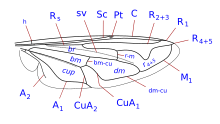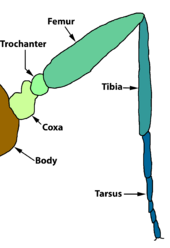Palpada vinetorum
| Palpada vinetorum | |
|---|---|

| |
| Scientific classification | |
| Domain: | Eukaryota |
| Kingdom: | Animalia |
| Phylum: | Arthropoda |
| Class: | Insecta |
| Order: | Diptera |
| Family: | Syrphidae |
| Genus: | Palpada |
| Species: | P. vinetorum |
| Binomial name | |
| Palpada vinetorum (Fabricius, 1798) | |
| Synonyms[1] | |
Palpada vinetorum is a species of syrphid fly in the family Syrphidae.[1][2][3][4] It is a native flower fly species to North America, mainly found in Texas and parts of the east coast.[5]
Description
- Length
- 10 to 14mm.
- Head
- Frontal triangle covered with white pile. The middle frons with a thin brownish stripe and yellow brown pile to the eyes.; Sime blackish pile notednear the ocelli. The face is reddish-yellow with whitish pollen and pile on the sides. The median stripe (tubercle) and cheeks shining, somewhat brownish. Antennae reddish-yellow, arista bare. Eyes are Holoptic in male. The occiput is black above, white pile below.
- Thorax
- Scutum has three distinct grayish-olivaceous crescent shaped bands over a opaque black base color., The first grey band is on the front border, the second just before the lateral suture, and the third, the broadest, is just in front of the scutellum, yellowish; pleurae are yellowish with grayish pollen. The scutellum is reddish-yellow with a lighter posterior border and long yellow pile along posterior edge.
- Abdomen
- The first segment is black, reddish-yellow on the sides. The second segment has large reddish yellow lateral spots, not quite reaching the hind border, The opaque black in the middle is very narrow, broader in front, and reaching across the segment in front of the indistinct yellow-brown hind border. The third segment with a large reddish- yellow spot on the sides, usually more reddish, than the second segment and with a narrow yellowish hind border. Across the middle, a shining baud with an opaque black spot in front and a similar colored band behind; In the female the yellow spots on the third segment are often smaller or wanting. The fourth segment has a shining cross-band in front, opaque behind and a broadly yellow posterior border.


- Wings
- Wings are hyaline except basal portion a little yellowish and they have a brownish tinge below the stigma.cell. Vein R1 is short petiolate and vein R4+5 distinctly sinuate. The spurious vein distinct.
- Legs
- The anterior and middle pairs yellowish or reddish, with the base of femora and tip of tibiae brownish. the hind femora considerably are dilated, usually broadly blackish, sometimes deep red.The distal half of hind tibiae is blackish.[6][7]
References
- ^ a b "Palpada vinetorum Report". Integrated Taxonomic Information System. Retrieved 2018-04-23.
- ^ "Palpada vinetorum species details". Catalogue of Life. Retrieved 2018-04-23.
- ^ "Palpada vinetorum". GBIF. Retrieved 2018-04-23.
- ^ "Palpada vinetorum Species Information". BugGuide.net. Retrieved 2018-04-23.
- ^ Machado, Isabel Cristina; Loiola, Maria Iracema (2000). "Fly pollination and pollinator sharing in two synchronopatric species: Cordia multispicata (Boraginaceae) and Borreria alata (Rubiaceae)". Revista Brasileira de Botânica. 23 (3): 305–311.
- ^ Skevington, Jeffrey H (2019). Field Guide to the Flower Flies of Northeastern North America. ISBN 9780691189406.
- ^ Hull, Frank Montgomery (1925). "A Review of the Genus Eristalis Latreille in North America". The Ohio Journal of Science. 25: 11–45. hdl:1811/2257.
 This article incorporates text from this source, which is in the public domain.
This article incorporates text from this source, which is in the public domain.
External links
 Media related to Palpada vinetorum at Wikimedia Commons
Media related to Palpada vinetorum at Wikimedia Commons
